Entries from November 1, 2009 - November 30, 2009
Daniel
 Thursday, November 26, 2009 at 12:24PM
Thursday, November 26, 2009 at 12:24PM 
When Frank Bruni re-affirmed the four-star rating for Daniel earlier this year, his endorsement came with caveats not usually found in such a review: “it yields fewer transcendent moments than its four-star brethren and falls prey to more inconsistency,” and a clunker rate “slightly higher than a restaurant as ambitious as this one’s should be.”
I gave Daniel four stars in March 2007, but as I look back on that meal, I think it was the least satisfying of those to which I’ve given the highest rating. This must be taken in relative terms: obviously the food was very good. But four stars, meaning “extraordinary,” must be something more than that. When I looked back on that meal, and realized I couldn’t even vaguely recall very much of it, I realized that I must have overrated the place.
 This feeling was cemented by a return visit last weekend. The décor has been brightened, the plush red velvet banished, but the food remains unexciting. I should clarify that our tastes are distinctly not biased against Chef Boulud because he has been cooking the same food for twenty years. We love the classics done well. Actually, there is nothing more exciting than breathing life into an old standard.
This feeling was cemented by a return visit last weekend. The décor has been brightened, the plush red velvet banished, but the food remains unexciting. I should clarify that our tastes are distinctly not biased against Chef Boulud because he has been cooking the same food for twenty years. We love the classics done well. Actually, there is nothing more exciting than breathing life into an old standard.
But among seven courses we had on a $185 tasting menu (click on image for a larger copy), there was not one I would especially care to have again. That’s not because there was anything wrong with them—to the contrary, I have great respect for the care with which most of them were put together. But all of that effort yielded curiously dull effects.
Part of me wished we had selected the $105 prix fixe. Several of the items offered there sounded a lot more interesting. On my next visit to Daniel—though I assure you, it probably won’t be anytime soon—we will probably go that route.
The bifurcated service at Daniel—one level for the anointed, another for everyone else—is the stuff of legend. We experienced none of this. We found all of the servers friendly, efficient, and highly professional.
 But there were several inexplicably long waits, which struck us more as inattention than snobbery. We figured that by 10:15 p.m., the time of our reservation, the restaurant would be starting to thin out. To the contrary, we were kept waiting until 10:45.
But there were several inexplicably long waits, which struck us more as inattention than snobbery. We figured that by 10:15 p.m., the time of our reservation, the restaurant would be starting to thin out. To the contrary, we were kept waiting until 10:45.
While we cooled our jets in the bar, it seemed like forever until someone came to took our drinks order. The party next to us endured a similar wait, and they appeared to be known to Chef Boulud, who came over to say hello; they were later seated in a secluded nook designed (or so it appeared) for V.I.P.s.
We do understand that restaurants sometimes run behind for reasons beyond management’s control, but we think an explanation—or at least an apology—was in order, and under the circumstances our drinks should have been comped.
The one thing they did to help us bide our time, was to serve the amuses-bouches in the bar (photo right).
When we were seated, there was another fairly long wait before bread (many varieties of it—none warm) was served. Once our tasting menu was underway, service moved along at a good, but not hurried, pace. As it was, we were not out of there until 1:00 a.m., by which time only one other table was still seated.
The tasting menu format offers choices for every course, and we diverged on all but one of them, which allowed us to taste a good cross-section of the menu. (Most of the tasting menu items are also available on the prix fixe.)


First Course:
- Mosaic of Capon, Foie Gras, and Celery Root. Pickled Daikon, Satur Farms Mâche, Pear Confit (above left)
- Pressed Duck and Foie Gras Terrine. Chimay Gelée Chestnuts, Red Cabbage Chutney (above right)
These were both labor intensive dishes, and you had to respect the artistry involved. The Mosaic of Capon was the more satisfying of the two.


Second Course:
- Maine Peekytoe Crab Salad. Celery, Walnut Oil, Granny Smith Sauce (above left)
- Olive Oil Poached Cod “en Salade”. Artichoke Puré, Tarragon Dressing, Lemon Zest (above right)

The crab salad was the more successful of the two. The juxtaposition with apples struck us as especially clever. The poached cod salad didn’t have much flavor.
We both made the same choice for the third course: Handmade Spinach Tortelloni. Chanterelles, “Tomme de la Chataigneraie,”, Lomo, Black Garlic (left).
(The other choice for this course was a butter poached abalone with yellow curry braised greens, crispy rice, and chayote.)
Once again, we were impressed by the amount of labor that had gone into this dish, but the flavors were far too muted.


Fourth Course:
- Whole Grain Crusted Skate. Chanterelles, Swiss Chard, Caper Chicken Jus (above left)
- Loup de Mer with Syrah Sauce. Leek Royale, “Pommes Lyonnaise” (above right)
The blizzard of vegetables surrounding the skate was arguably more impressive than the skate itself. The Loup de Mer was somewhat unappetizing; on the plate, it resembled an eel.


Fifth Course:
- Elysian Fields Farm Lamb Chop. Garbanzo Bean Fricassé, Chorizo, Rutabaga, Chickpea Tendrils (above left)
- Duo of Dry Aged Black Angus Beef. Red Wine Braised Short Rib with Parsnip-Potato Gratin, Seared Rib Eye with Black Trumpets. Gorgonzola Cream (above right)
The lamb and the short rib, although correctly prepared, seemed pedestrian for a restaurant on this level—or should I say, purported level. The ribeye was tough, and had none of the marbling that it should.



Sixth Course:
- Citrus Biscuit with Pink Grapefruit. Buddha’s Hand Lemon Confit, Mandarin Sorbet (above left)
- Warm Guanaja Chocolate Coulant. Liquid Caramel, Fleur de Sel, Milk Sorbet (above middle)
- Birthday Cake (above right)
The citrus biscuit was the best of the three. The chocolate coulant was dry, and we didn’t bother finishing it. The birthday cake was better.
The meal finished with petits-fours (average) and the warm beignets (excellent) that, by this time of the evening, sadly went to waste.
While Daniel has the format of a four-star restaurant, with its high ratio of servers to customers, high-end servingware, labor-intensive preparation, sauces poured at tableside, and so forth, we found the food uninspired and dull. We hold nothing against Daniel for serving the same classics year after year. But they need to inspire more than just “respect” for the level of effort involved.
We respect Daniel, but we did not love it.
Daniel (60 E. 65th Street west of Park Avenue, Upper East Side)
Food: **½
Service: **½
Ambiance: ****
Overall: **½
Belated Review Recap: A Voce Columbus
 Thursday, November 26, 2009 at 12:08PM
Thursday, November 26, 2009 at 12:08PM I came down with a cold on Tuesday, and didn’t get around to posting a Review Preview: a pity, as New York Journal needed a win, and we would have correctly predicted Sam Sifton’s verdict on A Voce Columbus: two stars:
There are two A Voce restaurants in New York City. One opened in 2006, off Madison Square Park. It is dark and almost romantic, loud when crowded, pretty after a fashion, perfectly good. The other opened in September on the third floor of the Time Warner Center, in the space that used to be Café Gray. The second restaurant is bright and airy, loud when crowded, pretty after a fashion, also perfectly good…
But make no mistake. A Voce is a corporate enterprise, part of a master plan, and feels like it. Save for swiveling yourself around in the Eames-y leather chairs that appoint both restaurants, there is very little room for improvisation. Service is clinical, almost silent, beyond language. Wine is what a chairman would expect, what most would order: a lot of big California cabernets, excellent chardonnays.
Sifton clearly visited the downtown site. It’s a pity he didn’t squeeze in two more meals there, so that he could re-rate A Voce Madison in the same review. It’s abundantly clear that he thinks the two are interchangeable, but A Voce Madison remains on the Times’s list of three-star restaurants, courtesy of an air-kiss blown their way by Frank Bruni in 2006. That was with Andrew Carmellini as chef, and even then it was over-rated.
 A Voce,
A Voce,  Missy Robbins in
Missy Robbins in  Review Recap
Review Recap 508 Restaurant & Bar
 Monday, November 23, 2009 at 04:15PM
Monday, November 23, 2009 at 04:15PM 
Note: 508 Restaurant & Bar closed in late 2014. A restaurant called The Houseman from Prune alumnus Ned Baldwin is supposed to replace it in early 2015.
*
 508 Restaurant is in that out-of-the-way district that some call West Soho or Hudson Square. Destination dining hasn’t proven itself here. The places that succeed are those that attract a repeatable neighborhood crowd.
508 Restaurant is in that out-of-the-way district that some call West Soho or Hudson Square. Destination dining hasn’t proven itself here. The places that succeed are those that attract a repeatable neighborhood crowd.
Maybe we need a new term for restaurants like 508: “neighborhood-plus.” The economics of West Soho are what they are, but the food here is a lot better than you’d expect for a local place. The restaurant has been open for just over a year, and the owners are now trying to raise its profile, hence the publicist’s invitation to dine here on a recent Friday evening.
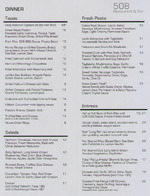 The chefs, husband and wife Jennifer Sant’anna Hill and Anderson Sant’anna De Lima, have restaurants like Lupa, Del Posto, and Aquavit on their resumes. Jennifer’s father and mother, Fred and Lynn Fisher Hill, both retired lawyers, are co-owners. Fred also serves as wine director.
The chefs, husband and wife Jennifer Sant’anna Hill and Anderson Sant’anna De Lima, have restaurants like Lupa, Del Posto, and Aquavit on their resumes. Jennifer’s father and mother, Fred and Lynn Fisher Hill, both retired lawyers, are co-owners. Fred also serves as wine director.
The menu is loosely described as Rustic Mediterranean. (Click on the image for a larger copy.) That strategy plays out in a long list of tapas qua appetizers and as many pastas as entrées. There is also the obligatory Pat LaFreida burger and barbecue spare ribs. I am not sure which Mediterranean country they come from.
I am told that everything is made in-house, except for the ice cream.
If you’re tempted to order three savory courses, as you would in an Italian restaurant, you’ll need to be hungry. The pastas are entrée size, and they’re excellent. If Andrew Carmellini served them at Locanda Verde, he’d be hailed as a genius. Come to think of it, he’s been hailed already.
The mains are arguably a bit expensive, with most of them $25 and over, but the portions are enormous, and they are quite good indeed. We were less impressed with the two tapas we tried.


Ham and Manchego Croquettes ($10; above left) left a curiously flat impression. Truffled Mac and Cheese ($14; above right) was good enough, but probably not worth the fifteen-minute wait for it to be made to order.

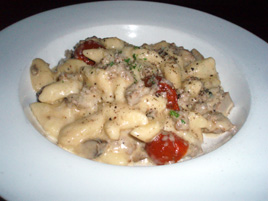
Spinach and egg fettuccini ($19; above left) came piled with roasted duck and skin cracklings, pine nuts, spinach, Brussels sprouts, and pancetta. Gnocchi ($18; above right) might be the lightest in town, as they’re made from celery root rather than potatoes, and served with lamb, Italian sausage, mushrooms, smoked tomatoes, and sage, in a creamy parmesan sauce.
It is not often that you find so many ingredients in a pasta dish, and yet find that all of them make a distinct impression. These are among the best pastas we’ve had all year.
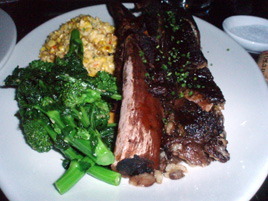

The Beef Long Rib ($28; above left) should be on many more menus. It is basically a whole short rib on the bone in a red wine-cranberry braise, with corn pudding and a terrific sautéed broccoli rabe. It takes guts to serve Miso Glazed Black Sea Bass ($26; above right) on a cuttlefish ink lemon risotto, but these chefs pulled it off.
The wine list has 30 bottles priced between $30 and $50, although the top end goes up to $300. I am not sure who will be spending that kind of money on this food, but it never hurts to have the option. Wine choices by the glass are ample, with a dozen reds and a dozen whites. There are 25 beers and also a very good sangria.
The space seats 60, including a small lounge up-front and a 12-seat communal table near the open kitchen at the back. The exposed brick walls are decorated with wine bottles and knick-nacks. We weren’t there as civilians, but service seemed to be attentive at all of the other tables I could see.
With its marketing position as a “neighborhood joint,” the owners here are being careful not to portray 508 as anything more than what it is. But even if you go out of your way to get there, 508 is more than good enough to justify the effort.
508 Restaurant & Bar (508 Greenwich Street near Spring Street, West Soho)
Review Recap: Oceana
 Thursday, November 19, 2009 at 11:37AM
Thursday, November 19, 2009 at 11:37AM Yesterday, Sam Sifton awarded the expected two stars to Oceana, finding that in the move to larger digs, it had lost a star along the way:
More recent meals in the new Oceana, which opened around the corner from Del Frisco’s in the McGraw-Hill building in August, reveal a different scene: a retort to all those who thought the old Oceana was cramped and outdated, a little too much actually like a steamship. It is now a massive restaurant, open and white and blue and tiled, with enormous lamp fixtures that throw light into every crevice of the room, with giant flowers to soften that and beneath them deep leather booths with velvet backs and walnut trim…
Those who order carefully can partake of fabulous meals. They will certainly drink good wine, off a whites-heavy list that is ably negotiated by both waiters and sommeliers alike. But if the Oceana of old was a pleasant, shipshape room with elegant food and a caring touch, the new version is a high-functioning luxury mill, designed to service pre-theater crowds and to celebrate corporate success on expense-account dimes. It is in some ways a very good restaurant. But the room ensures that it is not entirely a pleasant one.
Although this counts technically as a demotion (since the old Oceana had three stars), the review finds plenty of things to like. Still, the chef and the owners are no doubt disappointed.
We and Eater made the identical two-star bets, winning $3 against our hypoethetical one-dollar wagers.
| Eater | NYJ | ||
| Bankroll | $2.00 | –$1.00 | |
| Gain/Loss | +$3.00 | $3.00 | |
| Total | +$5.00 | $2.00 | |
| * * * * * * * * * * * * * * * * * * * * * | |||
| Won–Lost | 3–1 (75.0%) |
2–2 (50.0%) |
|
Life-to-date, New York Journal is 72–29 (71%).
 Livanos Family,
Livanos Family,  Oceana in
Oceana in  Review Recap
Review Recap Review Preview: Oceana
 Tuesday, November 17, 2009 at 06:25PM
Tuesday, November 17, 2009 at 06:25PM Tomorrow, Sam Sifton reviews midtown seafooder Oceana. The Eater Oddsmakers have set the action as follows: Sift Happens: 10-1; Two Stars: 3-1; Three Stars: 4-1.
Time is short, so we’ll make this brief. We think that Oceana is still a three-star restaurant—the rating it has had since…forever. However, we cannot deny that most critics have been less than rapturous since it moved into a more corporate-looking midtown location.
Our predictions since Sifton began have not been very good—we’ve been right only one out of four times, so take this with a grain of salt. We think Sam Sifton will award two stars to Oceana.
 Livanos Family,
Livanos Family,  Oceana in
Oceana in  Review Preview
Review Preview Kajitsu
 Monday, November 16, 2009 at 05:16PM
Monday, November 16, 2009 at 05:16PM 

 Among the many surprises in the latest Michelin Guide was a star given to Kajitsu, a tiny East Village Japanese restaurant that the mainstream critics practically ignored. Among major publications, four out of five stars from TONY was the only full review. The Times relegated it to Dining Briefs.
Among the many surprises in the latest Michelin Guide was a star given to Kajitsu, a tiny East Village Japanese restaurant that the mainstream critics practically ignored. Among major publications, four out of five stars from TONY was the only full review. The Times relegated it to Dining Briefs.
Some complain that the Michelin Guide fails to conform to “Received Wisdom” about what is good in New York, but I find it refreshing to find out about places the other critics overlooked. So we paid Kajitsu a visit on Saturday evening.
 Without a strong recommendation, this is not a restaurant I would have visited. It’s what Americans would call vegan. There are no animal products on the menu at all.
Without a strong recommendation, this is not a restaurant I would have visited. It’s what Americans would call vegan. There are no animal products on the menu at all.
In Japanese, it’s called Shojin, a Zen Buddhist practice based on respect for living things. Plates are artistically composed in the Kaiseki style, with an equal emphasis on taste and beauty.
 As a confirmed carnivore, I must admit that I would not choose a steady diet of this kind of food. I was willing to try it once.
As a confirmed carnivore, I must admit that I would not choose a steady diet of this kind of food. I was willing to try it once.
The only choices are the four-course menu for $50 or the eight-course menu for $70. (Click on the image to the right for a full-size copy.) Both change monthly. It seems silly not to spend $20 more for double the number of courses, and it appeared to us that most patrons felt the same.
The chef, Masato Mishihara, works quietly behind a blonde wood counter. He seems to do all of the cooking himself. There are several servers, all female, who tend to eight seats at the counter and eighteen more at the tables. The space was not full, and reservations had been timed to ensure that the chef could keep up without ever having to hurry.


The first course (above) was a slow braised Japanese turnip with black truffle and a bit of gold leaf. We were impressed by the sweet flavor of a vegetable not often served on its own. Like most of the courses, it came in a bowl that was as artistic as the food itself.


A Carrot and Shimeji Mushroom Soup (above left), with little flecks of mushroom tempura, was much better than I ever thought carrot soup could be.
The next course (below) included Fresh Diced Persimmon, Fig and Jicama with Creamy Sesame Sauce (basically a fruit salad) inside of a hollowed-out gourd. Alongside that was a hot House-made Tofu with Matcha Soy Glaze.


Just as impressive was the feat of hollowing out the gourds, which cannot have been easy.


Next came a House-made Soba Dumpling (above left) with a daub of wasabi. I appreciated the technical skill involved, but the taste was too monotonous for me.
The largest item (above right), which the servers described “the main course,” included a pumpkin wheat gluten called “fu” in a cranberry sauce, tempura vegetables, and salad greens. Like several other dishes, it illustrated the chef’s skill at combining local produce with Japanese technique.


The savory part of the menu ended with Matsutake Mushroom Rice and House-Made Pickled Vegetables (above left). We loved the vegetables, but the rice was merely adequate.
Dessert, described as a Chestnut “Yokan” Pastry (above right), was distinctly unpleasant. Just as perplexing was crumble of peanuts, resembling the leftovers of a snack served in coach.


Rakagun Candies (above left) weren’t impressive, even if they were imported from Kyoto, but I loved the intense fluffy green tea, mixed by hand with a whisk.
I respect and admire the chef’s skill. All of the courses were very good and beautifully presented, except for the desserts. But I am not eager to repeat the experience, especially at $70 per person before alcohol, tax, and tip. By the end, I was starting to pine for some animal fat. That shouldn’t necessarily dissuade you: remember, I am a carnivore.
You could easily miss the place. It’s on a non-descript block in the far East Village, not far from Tompkins Square Park, in the cellar of what appears to be a tenemant building. The rooms are the perfect picture of Buddhist austerity.
The servers are every bit as polished as the cuisine. There is a short list of sakes, wines, and beers, priced for any budget.
Kajitsu (414 E. 9th St. between First Ave. & Avenue A, East Village)
Food: **
Service: **
Ambiance: **
Overall: **
Review Recap: Aureole
 Wednesday, November 11, 2009 at 12:29PM
Wednesday, November 11, 2009 at 12:29PM Today, Sam Sifton dumps a single star on Aureole. Make no mistake about it: this is a pan, even though there are many dishes he likes—especially in the more casual front room:
Mr. Palmer is a big-business restaurateur, a best seller, the Dean Koontz of the sauté and oven set. It wasn’t always so. In 1988, he was just a brash young chef who had cooked at the River Café, who struck out on his own to open a creamy, luxurious town house restaurant, Aureole, on the Upper East Side. The food was American, audacious, often excellent and expensive despite a sour economy. It was New York to its core…
Times change. In 2007, Mr. Palmer announced plans to move the restaurant south, into bigger digs. The result is a Las Vegas event restaurant airlifted into Manhattan, a corporate cafeteria with a soundtrack of smooth jazz in the George Benson style. The food can be quite good. It can also be the opposite.
Aureole, as the New York expression goes, is meh.
Sifton confuses matters by assigning one rating to both the upfront bar–café and the $84 prix fixe dining room. For the former, one star is a compliment; for the latter, it’s a curse.
There was no Review Preview yesterday, as Sifton didn’t tweet in advance what he would be reviewing. It is just as well, as we would have been wrong again. We would have predicted two stars for Aureole. It will be interesting to see what happens next to Chef Chris Lee. He was turning out acclaimed food at Gilt. Now he is “meh.”
 Aureole,
Aureole,  Charlie Palmer,
Charlie Palmer,  Christopher Lee in
Christopher Lee in  Review Recap
Review Recap Convivio
 Monday, November 9, 2009 at 05:28PM
Monday, November 9, 2009 at 05:28PM Note: Convivio closed in March 2011, along with its sister restaurant Alto on the same day, due to unspecified “business circumstances.”
*
 Michael White is obviously not the only chef in this town with multiple restaurants. But the three he has are probably the most similar.
Michael White is obviously not the only chef in this town with multiple restaurants. But the three he has are probably the most similar.
Alto, Convivio, and Marea are all upscale Italian New York Times three-star restaurants. There are slight differences in focus—northern Italian, southern Italian, and seafood respectively—but the menus share a strong stylistic similarity.
There is nothing like, for instance, the huge difference between Daniel and Café Boulud, or between Jean Georges and Perry St.
On the bill, however, there is a huge difference, with four-course prix fixes of $89, $79, and $59 at Marea, Alto, and Convivio respectively. Location has something to do with it—Central Park South for Marea, midtown for Alto, Tudor City for Convivio. The expensive seafood ingredients imported for Marea are clearly a factor.
But after four visits to Marea, I am not yet quite persuaded that you get your money’s worth for $89. It is clearly a very good restaurant, or I wouldn’t have returned. But for $40 less per person, we had a terrific meal at Convivio last week that was better than any one of my meals at Marea. The only drawback is that you have to traipse to Tudor City, which is a moderate inconvenience.
 Convivio is in the space that had been L’Impero. Eric Asimov awarded three stars (when Scott Conant was the chef), but Frank Bruni demoted it to two, finding the food inconsistent, and complaining about “lugubrious” décor “evoking the upholstered interior of a very large coffin.” Ouch!
Convivio is in the space that had been L’Impero. Eric Asimov awarded three stars (when Scott Conant was the chef), but Frank Bruni demoted it to two, finding the food inconsistent, and complaining about “lugubrious” décor “evoking the upholstered interior of a very large coffin.” Ouch!
White and owner Chris Cannon took the critique to heart. If ever there were a makeover tailor-made to Bruni’s specifications, this was it. They brightened up the space, lowered the cost of the prix fixe, and added inexpensive tapas-like starters called sfizi.
Voila! Convivio was a three-star restaurant.
Convivio was never very high on our to-do list, mainly because we no longer trusted Bruni to evaulate Italian restaurants correctly. This time, perhaps he got it right.
You can order à la carte here, as at all of the Cannon–White restaurants. The sfizi are $4–7, antipasti $10–16, primi $23–25, secondi $26–35, desserts $11–15. But at $59 the prix fixe is a much better deal. There is only one dish that carries a supplement: the steak, which at $35 is the most expensive entrée. On the prix fixe, you’re basically getting the antipasto at half price and the dessert for free.


What can I say? We loved almost everything. Testa (above left), a deep-fried pork terrine, was complemented beautifully by a fried egg. Polipo (above right), or grilled octopus, was tender and smoky.
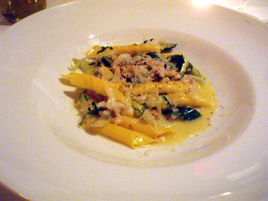
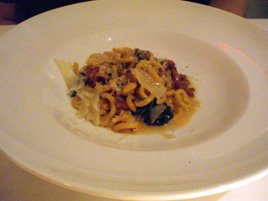
Garganelli (above left) came with a seppia & shrimp sausage, zucchini leeks, and peccorino; Gramigna (above right) with duck sausage, broccoli rabe, sage, and marsala.
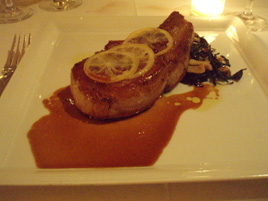
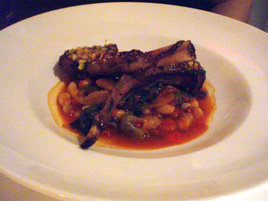
Maiale (above left), or a pork chop, was large enough to feed all of Tudor City. As good as it was, I had no intention of sharing.
Grilled lamb chops (above right) were delightful, but they were undermined by salsa verde, escarole, tomato and beans, which were far too overbearing and unsubtle.
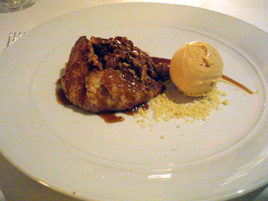

Heather Bertinetti, the young pastry chef at all three of the Cannon–White restaurants, is a real find. She hasn’t disappointed me yet. Crostata di Mela (above left) was an irresistible crumble of spiced apples, walnuts, and caramel gelato. Brasato d’Ananas (above right) made a hit out of vanilla braised pineapple, coconut custard, and mango sorbet.
Service was polished and professional. I especially appreciated the sommelier, who, when I asked for a recommendation at $60 or less, went all the way down to $45. It was a terrific choice too (the 2001 Majara), and on top of that he decanted it and offered us a copy of the label.
The restaurant wasn’t quite full, but business was certainly brisk. (When I called to confirm, a recording warned that our table would be forfeit if we were more than fifteen minutes late: ugh!) We may have lucked into one of the better tables, a two-top on the restaurant’s upper level, with no one nearby. Some of the tables are a bit more cramped than that.
No one doubts that Michael White is an elite chef. I’ve had my ups and downs at Marea, but I will likely return there somewhat regularly, as it is much more conveniently located, and I still have a lot of confidence in Chef White. But if you can get to Tudor City, Convivio may be the best way to experience his cuisine.
Convivio (45 Tudor City Place at 42nd Street, Tudor City)
Food: ***
Service: ***
Ambiance: ***
Overall: ***
The Burger at Lure Fishbar
 Friday, November 6, 2009 at 02:59PM
Friday, November 6, 2009 at 02:59PM  Lure Fishbar is best known as a seafood restaurant (click here for our review), but chef Josh Capon cooks a surprisingly good burger. His entry won the People’s Choice award at the recent Rachel Ray Burger Bash, part of the New York Food & Wine Festival.
Lure Fishbar is best known as a seafood restaurant (click here for our review), but chef Josh Capon cooks a surprisingly good burger. His entry won the People’s Choice award at the recent Rachel Ray Burger Bash, part of the New York Food & Wine Festival.
The burger he serves at Lure regularly appears on various “best burger” lists, so I was eager to give it a try. It sells for $15, which seems to be the going rate for burgers at upscale restaurants (not counting the crazy Black Label Burger $26 at Minetta Tavern).


Sure enough, he nails it. It’s not a match for the Minetta Burger (the $16 cheap option at the Tavern), but still plenty good—and unlike Minetta, you have a shot at getting a bar stool here at meal times. Capon doesn’t complicate matters. He just serves a simple burger, with enough heft that you can ask for medium rare and see red. It comes with a blizzard of condiments, but I didn’t need any.
Lure Fishbar (142 Mercer Street at Prince Street, SoHo)




